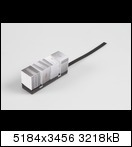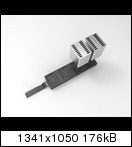Hey People,
In mid-July i will present my Bachelor-Thesis of Industrial Design. The topic is the evolution of computing power, with the main focus on videocards. I did some research on the technological progression, aswell as the socio-cultural aspect of the future workplace.
Based on this theoretical construct, i have developed a concept of an external graphics solution. I`d like to show you some very rough and early concepts/mock ups, in i would love to hear your feedback on the main idea.
As is the focus of my university, the concept needs to be very future-oriented, so existing technological restrictions like usb-bandwith or pcb-size are no restrictions.
What you see is basically an extrapolation, of what we might see in the future.
That beeing said, here ist the main idea: Graphics cards are the part of the hardware that have the fastest product cycles of all computer hardware, and also the highest performance gains per generation. So we see a more and more GPU-driven workstations around. At the same time, people want to be as mobile as possible, so we see more and more ultrabooks and even tablets used for all types of work around. Of course, those are very limited in processing power, especially in graphics power. The idea of an external graphics card is not new, but my take isnt based on how gpus look today, but rather how one could imagine them in the future.
Basically, my concept consists of a small docking station, which contains the power supply, and the ports. The GPU(s) are inserted from the top.
Here are some early sketches and mock-ups:






I would really like to hear your thoughts on this. again, it should be a concept for the future, so i will extrapolate some very efficient GPUs, smaller then ever (3D-stacking, SOC-principle)
It is more a draft for the future than a concept we would see tomorrow.
Just leave any thoughts you have on this topic.
Thank you for your time!
In mid-July i will present my Bachelor-Thesis of Industrial Design. The topic is the evolution of computing power, with the main focus on videocards. I did some research on the technological progression, aswell as the socio-cultural aspect of the future workplace.
Based on this theoretical construct, i have developed a concept of an external graphics solution. I`d like to show you some very rough and early concepts/mock ups, in i would love to hear your feedback on the main idea.
As is the focus of my university, the concept needs to be very future-oriented, so existing technological restrictions like usb-bandwith or pcb-size are no restrictions.
What you see is basically an extrapolation, of what we might see in the future.
That beeing said, here ist the main idea: Graphics cards are the part of the hardware that have the fastest product cycles of all computer hardware, and also the highest performance gains per generation. So we see a more and more GPU-driven workstations around. At the same time, people want to be as mobile as possible, so we see more and more ultrabooks and even tablets used for all types of work around. Of course, those are very limited in processing power, especially in graphics power. The idea of an external graphics card is not new, but my take isnt based on how gpus look today, but rather how one could imagine them in the future.
Basically, my concept consists of a small docking station, which contains the power supply, and the ports. The GPU(s) are inserted from the top.
Here are some early sketches and mock-ups:






I would really like to hear your thoughts on this. again, it should be a concept for the future, so i will extrapolate some very efficient GPUs, smaller then ever (3D-stacking, SOC-principle)
It is more a draft for the future than a concept we would see tomorrow.
Just leave any thoughts you have on this topic.
Thank you for your time!
![[H]ard|Forum](/styles/hardforum/xenforo/logo_dark.png)


